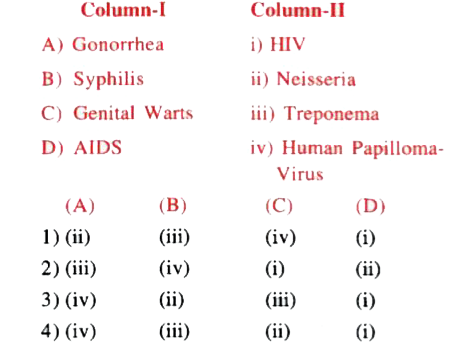Which type of vascular bundles participate in normal secondary growth of stem
Radial vascular bundle
All types of Conjoint, Collateral vascular bundles
Conjoint, Collateral, Closed vascular bundle
Conjoint, Collateral, Open vascular bundle
The correct Answer is:D
To answer the question "Which type of vascular bundles participate in normal secondary growth of stem?", we can follow these steps:
1. Understand Secondary Growth:
- Secondary growth refers to the increase in thickness or girth of a plant stem. This growth is primarily due to the activity of the cambium, a layer of meristematic tissue.
Hint: Remember that secondary growth is about increasing the thickness of stems, not just height.
2. Identify the Role of Cambium:
- The cambium is crucial for secondary growth as it produces new cells. It adds layers of vascular tissue (xylem and phloem) to the stem.
Hint: Think of cambium as the "growth layer" that helps in thickening the stem.
3. Types of Vascular Bundles:
- Vascular bundles can be classified into open and closed types. Open vascular bundles contain cambium, while closed bundles do not.
Hint: Focus on the presence of cambium when determining the type of vascular bundle.
4. Identify the Specific Type of Vascular Bundle:
- The type of vascular bundle that participates in secondary growth is the "open vascular bundle." In stems, this is typically found as "conjoined collateral open vascular bundles."
Hint: Recall that "open" means the presence of cambium, which is essential for secondary growth.
5. Structure of Open Vascular Bundles:
- In conjoined collateral open vascular bundles, xylem is located towards the inside, phloem is on the outside, and cambium is present between them, allowing for the growth of both xylem and phloem.
Hint: Visualize the arrangement: xylem (inner) - cambium (middle) - phloem (outer).
Final Answer:
The type of vascular bundles that participate in normal secondary growth of the stem is the conjoined collateral open vascular bundles.
- Secondary growth refers to the increase in thickness or girth of a plant stem. This growth is primarily due to the activity of the cambium, a layer of meristematic tissue.
- The cambium is crucial for secondary growth as it produces new cells. It adds layers of vascular tissue (xylem and phloem) to the stem.
- Vascular bundles can be classified into open and closed types. Open vascular bundles contain cambium, while closed bundles do not.
- The type of vascular bundle that participates in secondary growth is the "open vascular bundle." In stems, this is typically found as "conjoined collateral open vascular bundles."
- In conjoined collateral open vascular bundles, xylem is located towards the inside, phloem is on the outside, and cambium is present between them, allowing for the growth of both xylem and phloem.
The type of vascular bundles that participate in normal secondary growth of the stem is the conjoined collateral open vascular bundles.
টপার এই প্রশ্নগুলো সমাধান করেছে
- HISTOLOGY AND ANATOMY OF FLOWERING PLANTSBook:AAKASH SERIESChapter:HISTOLOGY AND ANATOMY OF FLOWERING PLANTSExercise:EXERCISE - II
Explore 214 Videos
- HISTOLOGY AND ANATOMY OF FLOWERING PLANTSBook:AAKASH SERIESChapter:HISTOLOGY AND ANATOMY OF FLOWERING PLANTSExercise:EXERCISE - III (PREVIOUS AIPMT/NEET QUESTIONS)
Explore 24 Videos
- HISTOLOGY AND ANATOMY OF FLOWERING PLANTSBook:AAKASH SERIESChapter:HISTOLOGY AND ANATOMY OF FLOWERING PLANTSExercise:EXERCISE - I (ANATOMY OF DICOTYLEDONOUS AND MONOCOTYLEDONOUS PLANTS)
Explore 60 Videos
- ENVIRONMENTAL ISSUESBook:AAKASH SERIESChapter:ENVIRONMENTAL ISSUESExercise:Exercise-III (Previous AIPMT/NEET Questions)
Explore 41 Videos
- HUMAN HEALTH DISEASEBook:AAKASH SERIESChapter:HUMAN HEALTH DISEASEExercise:EXERCISE - III (PREVIOUS AIPMT/NEET QUESTIONS)
Explore 56 Videos
সম্পর্কিত প্রশ্ন
Histogen theory was proposed by
View SolutionCortex is the region found between
View SolutionCasparian strip is a characteristic feature of
View SolutionWhich of the following in sewage treatment removes suspended solids?
View SolutionMatch the following sexually transmitted diseases (Colum-I) with their causative agent (Column -II) and select the correct option.

View SolutionAmphivasal or leptocentric vascular bundles are found in
Or
An example of monocots showing secondary growth in stems is
View SolutionVascular bundles in dicot stem are
View Solutionsecondary growth does not occur in monocots as their vascular bundles are
View SolutionIn monocot stems, secondary growth cannot occur because vascular bundles are
View SolutionName the type of vascular bundles of Cucurbita stem.
View SolutionIn barley stem, vascular bundles are
View SolutionAssertion. In dicot stem, vascular bundles are of open type. Reason. Dicot stem bears cambium in the vascular bundles.
View SolutionWhich type of vascular bundles participate in normal secondary growth of stem
View SolutionRead the following statements about dicot stem and choose the correct option
(a) Vascular bundles are arranged in a ring
(b) Vascular bundles are conjoint, collateral and open type
(C) Endarch type of arrangement of secondary xylem
View SolutionRead the following statements about dicot stem and choose the correct option (a) Vascular bundles are arranged in a ring (b) Vascular bundles are conjoint, collateral and open type (C) Endarch type of arrangement of secondary xylem
View SolutionIn monocote stem the vascular bundles are
View Solution
